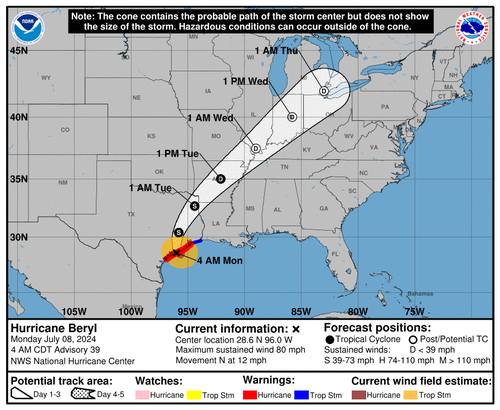Cat. 1 Hurricane Beryl Makes Landfall In Texas
Hurricane Beryl, the first Atlantic hurricane of the year to strike the US, made landfall in eastern Texas as a Category 1 storm in the early morning hours on Monday.
After causing billions of dollars of damage across the Caribbean and Mexico’s Yucatán Peninsula last week, Beryl has finally arrived near Matagorda Beach as a Cat. 1 storm with winds over 80 mph.
As the storm moves inland, torrential rains, surges, tornadoes, and high winds are expected across eastern Texas today. Some areas could receive 5-10 inches of rain, with isolated totals upwards of 15 inches.
“Life-threatening storm surge and heavy rainfall is ongoing across portions of Texas. Sustained tropical storm-force winds and hurricane-force wind gust have already been reported along the coast, these winds will continue to spread inland,” warned the National Hurricane Center.
A state of emergency has been declared across 121 counties. Nearly 300,000 Texas were without power as of 0600 ET, according to power tracking website poweroutage.us.
As the storm approached the Texas coast, we recently previewed (read: here & here) how major oil/gas infrastructure, either offshore or onshore, was possibly in the cone of uncertainty path.
On Sunday, Exxon Mobil said it was adjusting some operations, while Freeport LNG reduced liquefaction operations with plans to resume once the storm passes, according to Bloomberg.
In markets, WTI briefly tagged two-month highs of $84.50bbl, last seen since mid-April, but has since slid to the low $82bbl level.
“A much-anticipated move of Brent past $90 is going to be contingent on weather risk and a confirmation of a strong seasonal uplift in gasoline demand,” said Harry Tchilinguirian, group head of research at Onyx Capital Group.
Tchilinguirian noted, “If either does not materialize, the market is more likely to consolidate rather than race higher.”
Beryl was a close call for the Biden administration, which faces an active hurricane season threatening oil and gas refineries along the Gulf Coast. Any major storm that disrupts refineries or offshore drilling platforms could push the average price of gasoline to the politically sensitive $4 per gallon mark ahead of the presidential elections in the fall.
Tyler Durden
Mon, 07/08/2024 – 07:45

